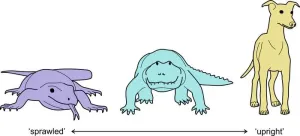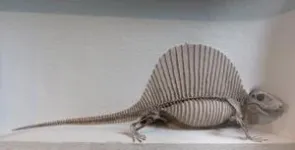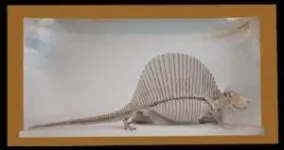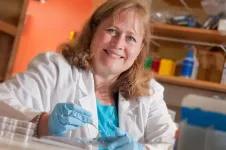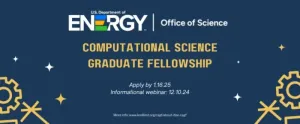The shift from a sprawled stance, like that of lizards, to the upright posture of modern mammals, as in humans, dogs, and horses, marked a pivotal moment in evolution. It involved a major reorganization of limb anatomy and function in synapsids—the group that includes both mammals and their non-mammalian ancestors—eventually leading to the therian mammals (marsupials and placentals) we know today. Despite over a century of study, the exact "how," "why," and "when" behind this evolutionary leap has remained elusive.
Now, in a new study published in Science Advances, Harvard researchers provide new insights into this mystery, revealing the shift from a sprawled to upright posture in mammals was anything but straightforward. Using cutting-edge methods that blend fossil data with advanced biomechanical modeling, the researchers found that this transition was surprisingly complex and nonlinear, and occurred much later than previously believed.
Lead author Dr. Peter Bishop, a postdoctoral fellow, and senior author Professor Stephanie Pierce, both in the Department of Organismic and Evolutionary Biology at Harvard, began by examining the biomechanics of five modern species that represent the full spectrum of limb postures, including a tegu lizard (sprawled), an alligator (semi-upright), and a greyhound (upright).
“By first studying these modern species, we greatly improved our understanding of how an animal’s anatomy relates to the way it stands and moves,” said Bishop. “We could then put it into an evolutionary context of how posture and gait actually changed from early synapsids through to modern mammals.”
The researchers extended their analysis to eight exemplar fossil species from four continents spanning 300 million years of evolution. The species ranged from the 35g proto-mammal Megazostrodon to the 88kg Ophiacodon, and included iconic animals like the sail-backed Dimetrodon and the saber-toothed predator Lycaenops. Using principles from physics and engineering, Bishop and Pierce built digital biomechanical models of how the muscles and bones attached to each other. These models allowed them to generate simulations that determined how much force the hindlimbs (back legs) could apply on the ground.
“The amount of force that a limb can apply to the ground is a critical determinant of locomotor performance in animals,” said Bishop. “If you cannot produce sufficient force in a given direction when it’s needed, you won’t be able to run as fast, turn as quickly, or worse still, you could well fall over.”
The computer simulations produced a three-dimensional “feasible force space” that captures a limb’s overall functional performance. “Computing feasible force spaces implicitly accounts for all the interactions that can occur between muscles, joints and bones throughout a limb,” said Pierce. “This gives us a clearer view of the bigger picture, a more holistic view of limb function and locomotion and how it evolved over hundreds of millions of years.”
While the concept of a feasible force space (developed by biomedical engineers) has been around since the 1990s, this study is the first to apply it to the fossil record to understand how extinct animals once moved. The authors packaged the simulations into new “fossil-friendly” computational tools that can aid other paleontologists in exploring their own questions. These tools could also help engineers design better bio-inspired robots that can navigate complex or unstable terrain.
The study revealed several important ‘signals’ of locomotion, including that the overall force-generating ability in the modern species was maximal around the postures that each species used in their daily behavior. Importantly, this meant that Bishop and Pierce could be confident that the results obtained for the extinct species genuinely reflected how they stood and moved when alive.
After analyzing the extinct species, the researchers discovered that locomotor performance peaked and dipped over millions of years, rather than progressing in a simple, linear fashion from sprawling to upright. Some extinct species also appeared to be more flexible—able to shift back and forth between more sprawled or more upright postures, like modern alligators and crocodiles do. While others showed a strong reversal towards more sprawled postures before mammals evolved. Paired with the study’s other results, this indicated that the traits associated with upright posture in today’s mammals evolved much later than previously thought, most likely close to the common ancestor of therians.
These findings also help reconcile several unresolved problems in the fossil record. For example, it explains the persistence of asymmetric hands, feet, and limb joints in many mammal ancestors, traits typically associated with sprawling postures among modern animals. It can also help explain why fossils of early mammal ancestors are frequently found in a squashed, spread-eagle pose – a pose more likely to be achieved with sprawled limbs, while modern placental and marsupial fossils are typically found lying on their sides.
“It is very gratifying as a scientist, when one set of results can help illuminate other observations, moving us closer to a more comprehensive understanding,” Bishop said.
Pierce, whose lab has studied the evolution of the mammalian body plan for nearly a decade, notes that these findings are consistent with patterns seen in other parts of the synapsid body, like the vertebral column. “The picture is emerging that the full complement of quintessentially therian traits was assembled over a complex and prolonged period, with the full suite attained relatively late in synapsid history,” she said.
Beyond mammals, the study suggests that some major evolutionary transitions, like the shift to an upright posture, were often complex and potentially influenced by chance events. For instance, the strong reversal in synapsid posture, back toward more sprawled poses, appears to coincide with the Permian-Triassic mass extinction—when 90% of life was wiped out. This extinction event led to other groups like the dinosaurs becoming the dominant animal groups on land, pushing synapsids back into the shadows. The researchers speculate that due to this “ecological marginalization,” the evolutionary trajectory of synapsids may have changed so much that it altered the way they moved.
Whether this hypothesis turns out to be supported or not, understanding the evolution of mammal posture has long been a complex puzzle. Pierce emphasized how advances in computing power and digital modeling have provided scientists new perspectives to address these ancient mysteries. “Using these new techniques with ancient fossils allows us to have a better perspective of how these animals evolved, and that it wasn't just this simple, linear evolutionary story,” she said. “It was really complicated and these animals were probably living and moving in their environments in ways that we hadn’t appreciated before. There was a lot happening and mammals today are really quite special.”
####
END
